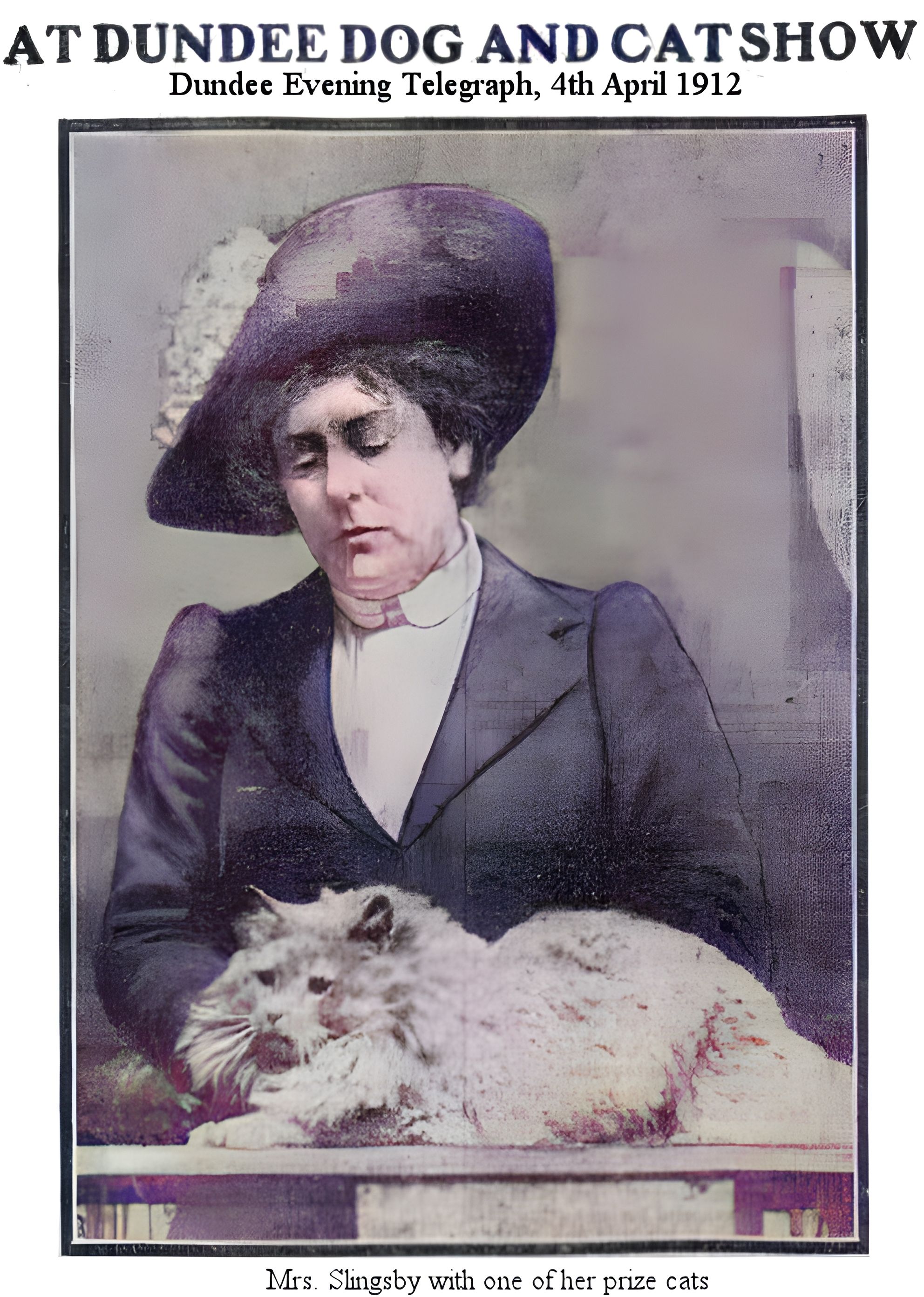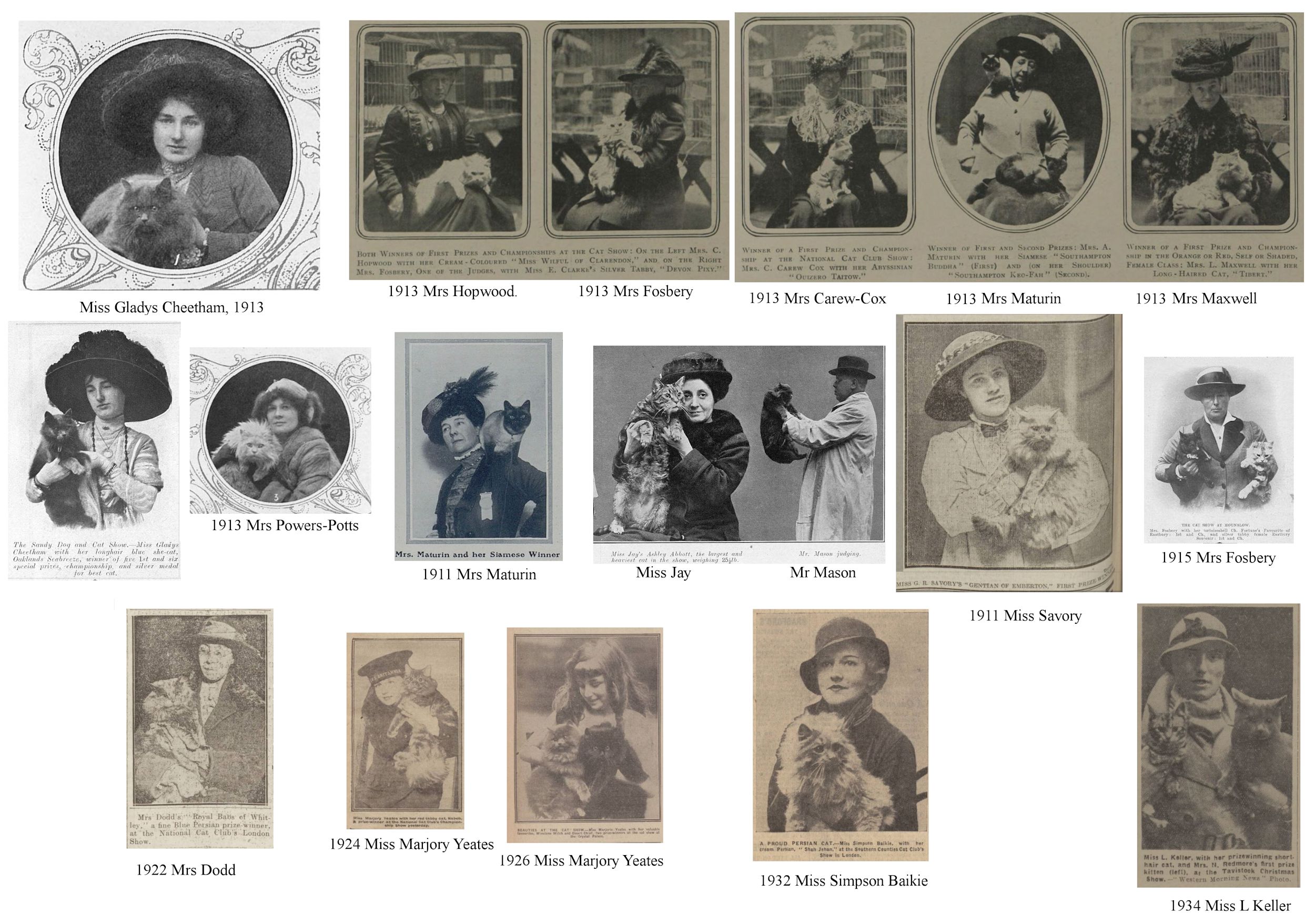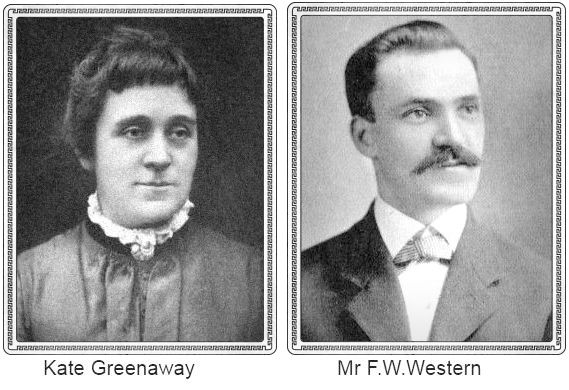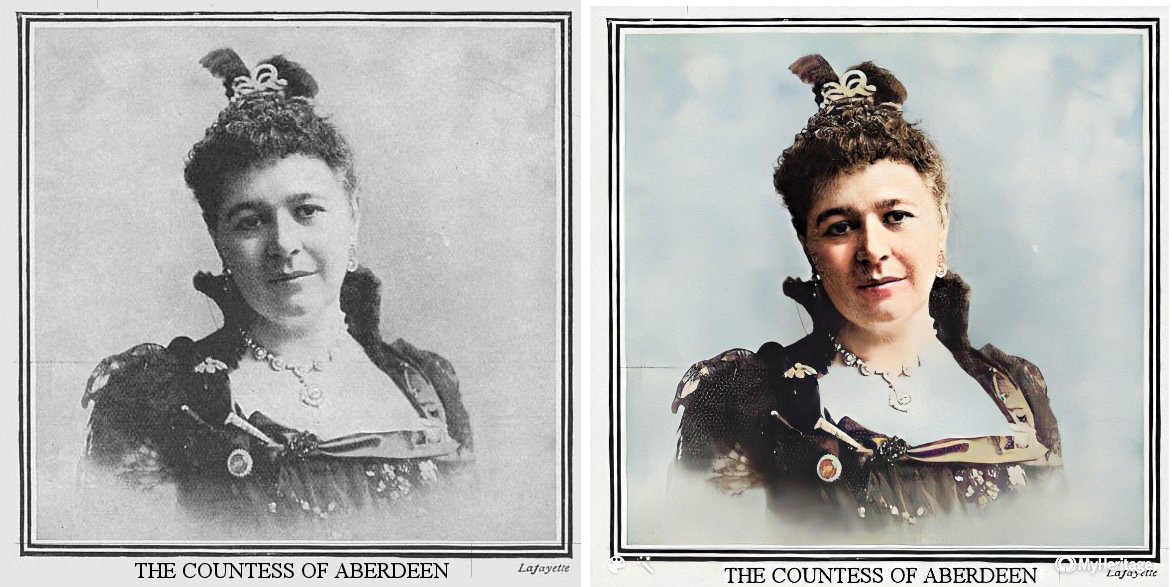
PROMINENT EARLY BRITISH CAT FANCIERS
Using various online archives and my own files, I thought it would be interesting to flesh out some of the prominent early cat fanciers on both sides of the Atlantic, most of whom were "society" people. This page details a number of early British fanciers.In doing so, I also found tales of scandal and financial ruin that beset the British aristocracy, as well as accounts of upstanding families involved in their community.
THE COUNTESS OF ABERDEEN

Another prominent aristocratic cat lover and, according to The Tatler (29th July, 1908), among her pet animals were some blue Persian cats which were most precious and which she had exhibited with success at the National Cat Show at the Crystal Palace.
Lady Aberdeen, formerly Ishbel Maria Marjoribanks, established the Haddo cattery, which was most famous for its silver tabbies. She married John Campbell Hamilton-Gordon (a cat and dog lover), 7th Earl of Aberdeen, and Haddo House was the ancestral home of the Gordons. She was very well educated and when, between 1893 and 1898 Lord Aberdeen was Governor General of Canada, Lady Aberdeen became the first president of the International Council of Women, an organisation that campaigned for women's rights. She also sponsored the Women's Art Association of Canada and helped establish the Victorian Order of Nurses. The couple returned to their homeland in 1898. Between 1906 and 1915, Lord Aberdeen was Lord Lieutenant of Ireland, and during that time Lady Aberdeen took an interest in the treatment and prevention of tuberculosis and improving children's health. She was committed to improving the lot of women and children and in social reform, but despite this she found time to breed Persian cats.The men in her life were noted animal breeds; her husband bred and exhibited Skye Terriers, and her father, Lord Tweedmouth, was instrumental in developing the Golden Retriever. Before the establishment of the cat fancy, it had been common for aristocratic wives to take up breeding toy dogs, while their husbands bred sporting dogs. Lady Aberdeen s breeding hobby was longhair cats; primarily Silver Tabbies (for which she was most famous) and Blue Persians, and to a lesser extent Black, Smoke, Brown Tabby and a Tortoiseshell and White Persian. She was one of many early aristocratic ladies involved in the 1890s cat fancy, and remained involved into the early 1900s. The aristocratic lady breeders were well connected with each other, buying and selling breeding cats between themselves. Her choice of breeding cats demonstrate an understanding of line-breeding and matching cats with complementary traits to produce healthy cats, not just winning cats or large numbers of saleable kittens, at a time when too many breeders/exhibitors were pot-hunters (to paraphrase Lady Marcus Beresford). She appeared interested in improving all qualities of her chosen breeds, not just the show-bench potential.
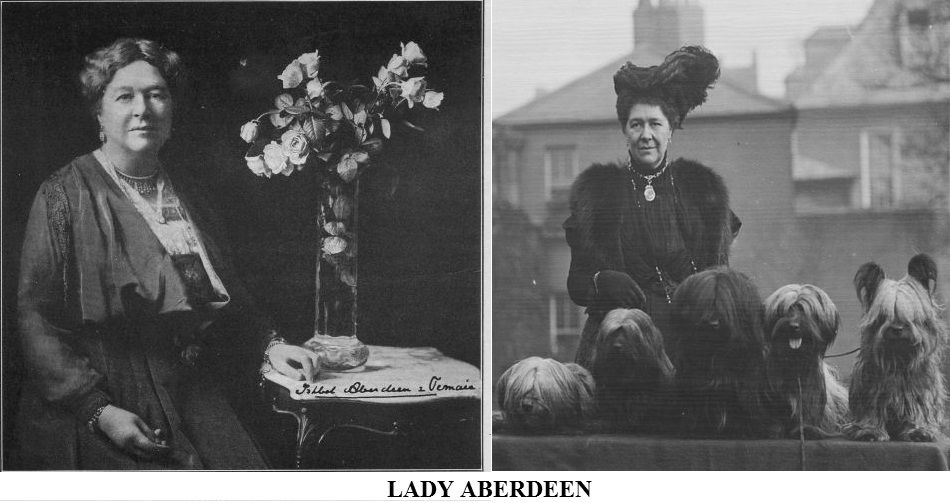
LADY ABERDEEN AND CATS. Aberdeen Press and Journal, 17th September 1901
Lady Aberdeen shows her interest in the fashionable cat cult by offering a silver model of a cat as a challenge trophy for the best silver tabby, to be competed for at the cat show which is being organised by Lady Marcus Beresford in aid of Princess Christian's Nursing Home at Windsor. The Princess has promised her patronage for the show, which to be held on September 27 at the Leopold Institute, Slough. Mrs Mackenzie Stewart and Mrs Vary Campbell will be among the judges, and cups and money prizes are being offered by Lord and Lady Marcus Beresford, Lily, Duchess of Marlborough, and others interested in the rearing of prize cats and in the object of the show, as well as by the various cat societies. Cat culture is now quite a society craze, and not a little money is made by successful votaries of the cult who acquire a reputation for certain varieties such as silver or blue or tortoiseshell, Persians, or Siamese cats. There is a fashion in the colour and species of cat, as in most other things, and just now cream-coloured Persians are in the ascendant. Lady Marcus Beresford is one the most successful of the society breeders of cats.
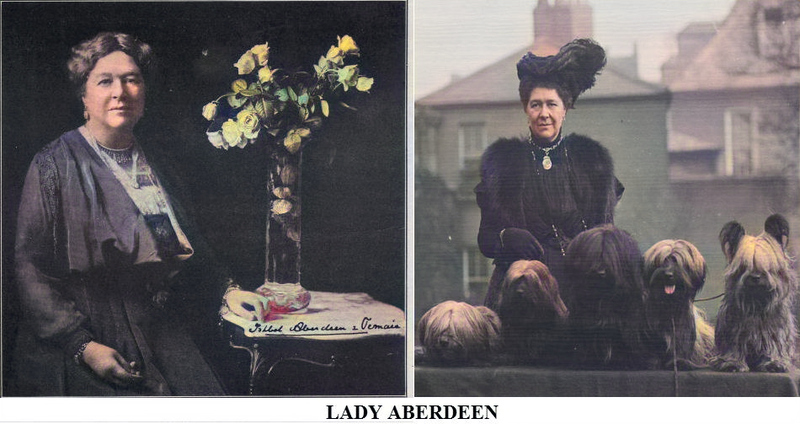
Aberdeen Press and Journal - Thursday 19 September 1901
Lady Aberdeen, who is to present a handsome trophy for the best silver tabby at the forthcoming cat show, to be held in aid of Princess Christian s Nursing Home at Windsor, is very fond of cats. She has a number of fine silver-grey tabbies at Haddo House, where they have comfortable quarters in the poultry buildings. The pussies are extremely friendly towards visitors, and if one receives more than its share of attention, the remainder are not slack in putting forward their claims. While Lady Aberdeen keeps her cats because she is attached to them [goes on to discuss poultry]
ADIEU TO VICEREGAL PETS. Daily Mirror, 23rd December 1913
Dec. 22. The Countess of Aberdeen has said "'Good-bye" to her pets, for she has given up her interesting kennels of dogs and cats at the Viceregal Lodge. These kennels formed her chief hobby, and she now intends to devote herself to health work. Her collection of dogs and cats was a splendid one.
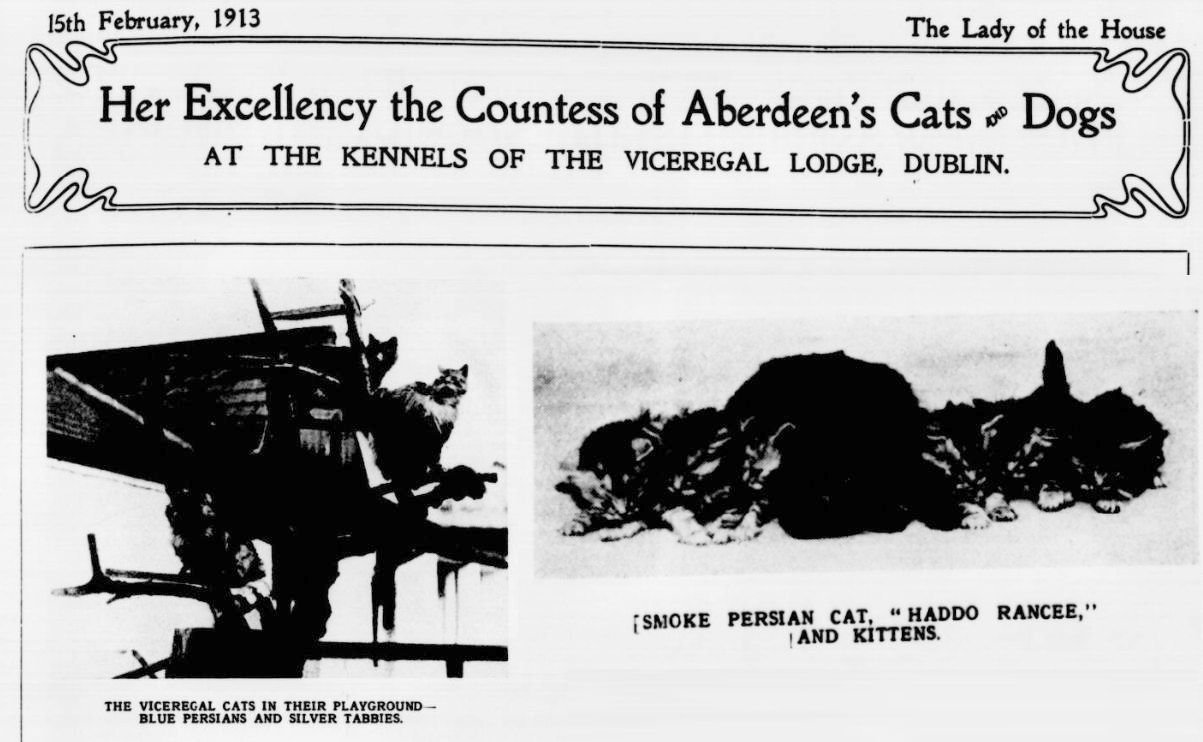
MRS. BAZELEY

ISLE OF CATS. PERSIANS THAT HAVE WON 300 PRIZES. Reynolds's Newspaper, 13th January 1935
Near West Drayton, Middlesex, there is an island of the Thames devoted to the comfort of cats. The only other occupant is Mrs. Hazeley, a breeder of blue and cream Persian-
Mrs. Bazeley told "Reynolds's" - "I feed them on fish, milk, raw eggs, and brown bread. My Persians have won nearly 300 prizes, including gold medals."
Blue Benjamin, a member of the National Cat Club. weighs 15 lb. He has many kittens now living on the Continent.
"People send their cats to be mated, and I then dispatch them by air to France, Belgium, and Holland," Mrs. Barkley said. "I bred Billy Bumpet, who was claimed to be the world's most famous cat. He is buried on this island."
LUXURY ISLE FOR CATS. RIVER HAVEN NEAR LONDON. Sunday Mirror, 13th January 1935
I have just visited an isolated island near West Drayton (Middlesex), on the River Colne, where cats from all over the country are sent to mate with prize Persians. Accompanied by Mrs. Bazeley, England's most successful breeder of Persian cats. I inspected the luxury homes of cats who are fed on fish, milk, raw eggs and brown bread.
"Cats are now sent to me to be mated, and then dispatched by air to France, Belgium and Holland. I have nearly 300 prizes including gold medals for prize Persians," Mrs. Bazeley said.
Benjamin, a 15 lb. blue Persian, appeared nonchalant to the fact that nearly a hundred of his kittens were now residing on the Continent. "He is the grandson of Billy Bumpet who was claimed to be the world's most famous cat. Billy is buried on this island," Mrs. Bazeley told me.
All her cats are members of the National Cat Club, and she has secured as much as 65 for a prize kitten. Mrs. Bazeley and her husband are the only inhabitants of the island where they have to use oil lamps and draw well water.
MRS. BULLER
PROFITABLE ANIMALS. Belfast News-Letter, 1st September 1894
In these days, when most of us are ever seeking new ideas for the accumulation of that excellent thing which paltry poets describe as paltry dross, a new idea is always welcome, though one would scarcely expect the humble grimalkin to be a source of wealth. Nevertheless, Sylvia's Journal" for this month shows us that nice little sums are to be made out of the careful treatment and breeding of cats. One of the most successful amateur cat fanciers is Mrs. Buller, who has a cattery" at her picturesque country house in Surrey. In reply to Sylvia's" interviewer, Mrs. Builer showed that pussy can be made a profitable as well as an affectionate pet.
If properly managed," said Mrs. Buller, "cats can be made to pay well. A friend of mine made 240 in two years by prizes, sales, and stud fees. Of course, you must start with pedigree animals, and these are costly. The best plan is to choose one or two breeds, and try to perfect them. I am endeavouring to produce unmarked orange Persians, and am succeeding beyond my expectations. You shall see my lovely Marigold, with tier superb brush; Cowslip, too, and Buttercup, for I name them all after golden flowers. They are worth a considerable sum, orange Persian kittens fetching three guineas for females, and four guineas for toms. Long-haired cats are the most popular and, in my opinion, the most attractive. You must come and see my pets, although they all appear at a great disadvantage just now. It is the cats' moulting season, and every one of them is out of coat. Besides, a dreadful epidemic of influenza has been right through my cattery, and the poor things are only just recovering. Some were so ill that my maid and I took it in turns to sit up all night with them.
Then Zula was introduced, a splendid fellow, whose tint to the initiated is light blue, but to the common mind more like slate colour. Afterwards followed Miss Betty, a beautifully-marked tortoise-shell, who took first prize at Cruft s Aquarium Show, and a pair of royal cats of Siam, from whom great things are expected.
"Of course," continued Mrs.Buller, I have to take great care of mv pets. The secret of success is judicious feeding and an avoidance of coddling. My kittens spend the day in the garden whenever the weather permits. The flower beds are covered with cocoanut fibre, in which they frollick about. You must never let Persians be out of doors in the wet. Their thick coats will not dry easily, and they get chills and die. I lost a superb tom from that cause a little while ago."
MISS GLADYS CHEETHAM
Gladys Cheetham was a young, but very organised and competitive cat fancier who bred blue Persians at Oaklands, Brighouse. She had also exhibited pigeons at local fanciers shows. Her father, Mr. J.A. Cheetham of the silk-spinners firm of Messrs. J. Cheetham and Sons Ltd, was a successful breeder and exhibitor of pigeons and poultry and he would have preferred his daughter to breed and exhibit Pomeranian dogs rather than longhair cats. Gladys, however, was not to be dissuaded so her father obtained the best possible foundation stock for her cattery, and then left her to it, though he expressed pleasure at her triumphs. In 1916, Gladys married into another family of silk spinners and became Mrs. Gladys Wood, although cat fanciers continued to recall her as Miss Cheetham.
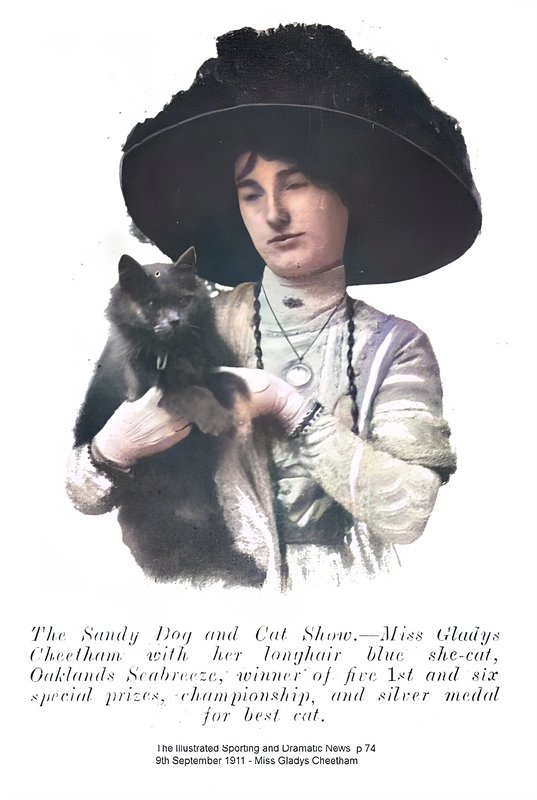
MISS CHEETHAM'S CATTERY AT OAKLANDS, BRIGHOUSE. The Queen, 28th February 1914
It was not the mewing of cats, but the barking of dogs that welcomed me to Oaklands on the occasion of my recent visit. So I will first mention Peggy Black, a well-bred Pekingnese, and Peggy Red, a nice Dachshund, the property of Miss Gladys and Miss Dorothy Cheetham. They have the run of the house and grounds and are on good terms with the inmates of the cattery, whose buildings occupy over an acre of ground. Some of these are transformed poultry sheds, others are new spacious houses with ample wired-in runs. In the midst of them is a rosary and beyond a kitchen and fruit garden. I introduced Blue Persians into England more than thirty years ago, and I can honestly say I never have seen a more beautiful collection of these cats. I was invited to accompany Miss Gladys Cheetham on her morning feeding round. She carried a large deep can of steaming cooked meat, and with a wooden spoon distributed it in the clean earthenware dishes placed ready in each cattery. We came first to the large enclosure where Stedfast, the superb stud cat, lives, disporting himself. He was told to roll for missus, whereupon the big fluffy fellow threw himself down and turned over and over. Then having earned his meal he quickly set to work on the well-filled dish of meat. This grand male has been Miss Cheetham s property for a little over a year, and has won five championships. His eyes are so deep in colour as to be startling, and the only other member of the establishment that has such gorgeous orange eyes is a queen recently purchased from Mrs. New, and this one occupies a cattery close to Stedfast. When Seket of Egypt turned her gaze on me I felt that to her belonged the honour of having the best orange eyes in the Oaklands Cattery. I was introduced to Sultan, a big burly male, bred by Miss Cheetham, and his wealth of body coat is extraordinary. His sire is Spearrmint, also a grand coated cat, but rather narrow in head. Sylvio, another cat, is true blue in colour, neither too dark nor too light, and sound throughout. This Irish cat also has gorgeous eyes.
Then as we passed on I saw Sceptre, who with her broad head, massive limbs, and unusual size, might be mistaken for a male. She has won more prizes than any other blue female, and her championships number ten, while she has twice been Champion of Champions at Westminster and Birmingham. She has won three times the Best in Show award, but so far has been rather a disappointment as a breeder, for although two litters were born last year, they did not survive. Sheila is another grand blue queen, and in eye and shape is hard to beat. She had a litter, now eight months old, by Stedfast, and two of these, Sybil and Sue, were two lovely snub-faced kittens with glorious eyes, Miss Cheetham is very proud of this promising pair. Sheila, the mother, has once been the Best in the Show. Her grown-up daughter, Stella, by Big Ben, is a taking little cat, full of quality, but on the small size. She had a touch of show fever on one occasion, when her owner had a run of bad luck and lost several valuable kittens. Stella s hardy constitution pulled her through, but the illness stunted her growth. She has had one kitten, and Simole is a fine specimen who, with Sybil and Sue, made a dash for their plate of food and then tried to take pot luck from the deep tin of meat by dipping their paws down and fetching up tit-bits. Oaklands Seabreeze, by Sir Archie of Arrandale and Oaklands Sceptre, is a cat that carries great wealth of coat. She has twice been the Best in the Show and has won five championships.

Another promising young queen bred by Miss Cheetham is Oaklands Selma, who made a successful debut at the last Westminster Show, gaining equal second with Sheila in the open classes for females, and she was also awarded the special prize for the best novice cat in the show. Her coat is so long that her feet are almost hidden. Sapphire, the oldest queen at the Oaklands Cattery, has done a good deal of winning in her day, and is noted for her lovely head.
A dainty little queen is Desdemonda, a recent purchase from Miss Clements, sired by her fine stud cat, Desmond. This kitten has never been shown, but should give a good account of herself when she is. The last of the blues, though certainly not the least, were the two huge beauties, Stealaway and Sete. It is in a spacious run that such huge creatures are to be seen to advantage and not in the show pen. Stealaway s grand head, short face, and fine eyes always gain him first-class honours in the only class in which he can be exhibited. Sete was purchased from Mrs. New. In one of the catteries I was interested to find a pair of brown tabbies. The male, who is fine in colour with grand markings, is a son of Brown Bruno, and appropriately named St. Bruno. His little mate has a sweet round snub face and tiny ears. A bright coloured orange female was in the same run, a recent addition from the Swinton Cattery.
As we returned to the house, Miss Cheetham remarked that she must show me her Black Boy, and opening the cattery out ran a great big fellow. He may be termed the beginning of the Oaklands Cattery in 1909, and his owner says he brought her luck, and she never means to part with this son of Big Ben. Indoors I was shown a cabinet containing the many special prizes, for Miss Cheetham has won 243
A BRIGHOUSE WEDDING. WELL-KNOWN LOCAL FAMILIES UNITED Leeds Mercury, 27th January 1916
A wedding of considerable interest took place at St. Martin s Church, Brighouse, yesterday afternoon, by which families well known in the industrial life of Brighouse were linked. The bride was Miss Gladys Cheetham, elder daughter of Mr. and Mrs. John A. Cheetham, Oaklands, Brighouse, and the bridegroom Mr. Herbert Wood, only son of Mr. Thomas H. Wood, J.P.. and Mrs. Wood, Glenthorne, Brighouse. The bride s father is a member of the firm of Messrs. J. Cheetham and Sons Ltd., silk spinners, Brighouse, while the bridegroom is connected with the firm of Messrs. Wood Bros, and Sons Ltd., silk spinners, Brighouse. The bride, who was given away by her father, wore a simple but effective gown of ivory satin duchesse, the overskirt and coatee being of Bruxelles lace, finished with iridescent pearl tassels, and the long sleeves and Medici collar also of Bruxelles net. She wore her mother s wedding veil, which, in cap fashion, was held in place with a wreath of white heather and orange blossoms. The bridesmaids were Miss Dorothy Cheetham (sister of the bride). Miss Winnie Cheetham (cousin of the bride), and Miss Cabert, of Southport (cousin of the bride). Mr. Harold Edwards, of Brighouse, was best man.
The couple had one daughter and moved to Green Royd, Rastrick, and later to Southport. Herbert Wood died in 1950 and Gladys died 31st July 1968.

PHARAOH'S LEGACY. FROM GARDEN VARIETY TO CRYSTAL PALACE WINNER. By W. Hanson. - Todmorden & District News, 17th August 1928
But there are cats and cats. I have here a photo of Sceptre, then the champion of the British Islands, and foremost of first and special prize winners at the Crystal Palace and everywhere else. A magnificent Persian, of a rare slatey blue colour, with orange eyes. It belonged to Miss Gladys Cheetham, Oaklands, Brighouse, and niece of Miss Fanny Lord, of Cliffe Villas. Though not more than 18, Miss Cheetham had no less than 27 valuable Persia cats, which were kept outside in aviaries, among the grounds at Brighouse, and whatever might be each cat s name, it always began with S, as, for instance, Spartan, Seabreeze, or Snowball. But the Feathered World, Bazaar, Fur and Feather, and such journals were eloquent in description and pictures of Miss Cheetham s peerless Sceptre. Naturally, high prices were offered for the Crystal Palace winner, but she refused to take a 200 offer for the cat which had won its weight in gold, though 5, 10, or 20 might, or might not, be taken for a Persian kitten.
Miss Gladys and Dorothy Cheetham were what you would call prepossessing, clear-complexioned girls, with deep blue eyes, and a profusion of dark, chestnut hair, each of a jolly disposition, and perfect adepts with the embroidery needle, or with many coloured wools and silks, Usually the sisters wore each a sealskin coat lined with silk when going on a journey. Thus Miss Cheetham would stay overnight at the Crystal Palace on the morrow. But let it be the Duchess of -----, Lady ----, The Right Honourable ----, or any renowned exhibitor of Persian or Abyssinian cats, the eighteen-year-old girl from Oaklands, Brighouse, would sweep the deck of its coveted golden trophies as sure as they were there, literally by the wielding of her Sceptre, the most perfect Persian in the British Isles. Ultimately, she married a commissioned officer of the Great War, since elect as the High Sheriff of Carnarvon, North Wales, the son of a silk manufacturer of Brighouse who received a knighthood. She and her husband keep a large house at Llandudno during the summer months, but Dorothy Cheetham became the daughter-in-law of the Mayor of Southport, where she lives.
MISS HESTER COCHRAN
ABOUT CATS. The Topeka State Journal, 23rd November 1899
Among the best known and widest-famed of catteries in England, which year by year are becoming more numerous, as puss advances in popular favor and fashion, is Miss Hester Cochran's excellent collection now housed at the cottage, Witchchampton, Wimborne. The cats mostly made their names - and their owner's - while she and they were living near Salisbury, at Alderholt, and have only lately been transferred to the silvan seclusions of Witchampton, one of the prettiest villages in pretty Dorsetshire, says the Ladies' Pictorial.
Silvers, shaded silvers and silver tabbies, but more especially the former, are perhaps Miss Cochran's special specialty, and she has bred and owns some of the best unmarked silvers of the day. A prettier creature in this line than Mistress Dimity, for example, it would be hard to imagine, nor one more free from every shade of contaminating color, and more evenly and purely akin to the precious metal she represents. Shown but twice, she took in first, second and two specials, but has renounced an exhibition career. A cat of character, her children inherit some quaint traits, among them a strong family attachment. Her kitten play unweariedly together, but treat any advances from scions of other races with cold contempt; no "Dimity" kitten forms any attachment outside its own family, and consequently it is desirable to deal with them in couples! The present infants of the ilk are a promising little pair, the female an especially lovely, pale and pure silver without the slightest marking of any kind, beautifully shaped, with an exceptionally fine head and limbs, an immense brush, and the promise of much coat; altogether a treasure such as all silver breeders, and silvers are certainly the most difficult of all Persians to produce in anything like perfection, must long, at the merest sight, to possess. Another merit, shared by the other members of the family, is her extremely sweet temper; even the generally abhorred process of the daily combing, provocative in most cats of much red rapine - tooth and claw - after nature's best traditions, is undergone in amiable resignation.
That the daily toilet alone, to say nothing of all the other cares of feeding and rearing - the diet table at Witchampton is on the most liberal scale - take time is easily to be imagined. Miss Cochran tends her pets herself, maintaining that disaster is sure to attend her absence from them, in which opinion most cat-owners will heartily concur. Partly for their attractions per se and partly for the benefit of the cattery, a typical little herd of goats is kept and, like the cats these are of the very best of their kind, which, in one instance at least, that of the Nubian goat, Marmion, is one to strike the most ignorant beholder with admiration.
The sultanship among the silvers, a position formerly occupied by Sweet Boy, now given to Fitz Eustace, a fine young cat, even paler in color than Dimity, with a wide head, big eyes of the most correct emerald. He was sold from the cattery as a kitten to Mrs. Marriott, but on seeing and coveting him in the spring Miss Cochran persuaded his then owner to allow her to repurchase him. Another fine cat is Blue Robin, a light blue with silver ear tufts and a silver chin. He is the possessor of a tremendously wide head, unusually short legs and a heavy coat, which advantages secured him a challenge cup and two specials on the solitary occasion of his making a public appearance at Westminster. Another blue is Mokanna, a kitten.
The latest of Miss Cochran's hobbies is for Siamese cats, and she has gone about it must thoroughly and systematically, reading all she could on the subject - its literature is not extensive - and collecting information in every quarter for the better understanding of this most interesting breed. Her conclusions, summed up in various most able and interesting articles - for though "but a lassie yet" Miss Cochran is a very clever litterateur - are somewhat to the effect that the Siamese themselves are slightly obscure as to the respective merits of kinked and non-kinked tails of "royal" and "ordinary" points, and consequently and inevitably, until some one comes forward with a tabulated scheme of the Siamese as it should be, differences of opinion among judges are temporarily unavoidable.
Be this as it may, no admirer of the breed could fail to include Krags among the best of his race. His is a most independent, quaint personality, well worth preserving, even though doing so, in his interest owner's case, has entailed nursing him through a severe illness, during which he occupied her own room und exacted incessant attention. All the more gratifying was her elation, when he rose from his sick bed somewhere about 4 o'clock of a certain morning, mounted a tall chest of drawers, and sang! The song of the Siamese cat is one which no pen less than that of a Carlyle, dipped in luridly powerful ink, could describe, and Krags sings it with feeling and expression. His markings – the dark seal-colored reliefs to a clear fawn coat, short und velvety - might be better, but In form he is excellent, very large and with a fine head and eyes of true, cerulean hue. His wife, Susa II., is a charming little person, with pretty marking and the most intense of sky-colored orbs, who came from Mrs. Sutherland, of Siamese fame, and is descended from Miss Forestier-Walker's celebrated cats as is Minthamee, her half sister, a traveled princess, who came from France at 2 months old, and has since spent three weeks successively in London Dumfriesshire and Glasgow with her mistress.
And now we come to the gem of the cattery, as far as rarity goes for a pure white Manx cat, named Pan, absolutely genuine in breed, as his shape, with the hare-like hind legs, shows, is a curiosity, not to say a thing of loveliness, not to be picked up every day. Miss Cochran possessed two of these really exquisite kittens, but under an old engagement, reluctantly parted with one, now the property of Lady Alexander. To the remaining one she is fondly attached and describes him as a most intelligent beastie, quite above the average as a companion and very lovably in all his ways.
From cats to horses Is a sheer descent, but a word must be passed with the smart little trapper who is enjoying life in a flowery field hard by. Quiet nice tempered and a pretty mover, she responds most creditably to the breaking she has had from Miss Cochran, who is an accomplished horse-woman, rides close up to hounds and can do more than make a 3 year old.
MRS. G. J. COCHRANE
Mrs. G. J. Cochrane, of Cambridge Gardens, Pilrig, Leith, N.B . . .In addition to Pomeranians, Mrs. Cochrane is a breeder and exhibitor of Persian cats, Chittieh, one of her successful exhibits being illustrated. In both cats and dogs it is Mrs. Cochrane's opinion that they are what the owner makes them. The Gentlewoman, 13th September 1919
REV. P. L. COSWAY
THE CURATE AND HIS CATS. VALUABLE COLLECTION OF PERSIANS AT OUTWOOD. HOW THEY ARE FED AND REARED.
Yorkshire Evening Post, 7th November 1901
For good coals and pretty cats there is place like Outwood, near Wakefield. The feline fame of the village is of quite recent creation. Eighteen months ago the bachelor-curate of Outwood (the Rev. P. L. Cosway) sold off his Bassett hounds, his fox-terriers, and his Blenheim spaniels, and took to cats. Acting on the advice of an eminent catologist he purchased the most beautiful blue Persian Queen Angela mated her one Blue Noble a Thomas cat very high degree-and there were kittens, the family now comprising three sons Rupert. Imperial Blue, and Blue Knight and one daughter, the lovely Lurline. All these reside in the green-painted cage-windowed apartments in Mr. Cosway s pretty back garden. An orange Persian cat, two smoke Persian cats, and one real bloodhound also occupy little wooden houses in the same back garden. The cats are fed on Neaves s food and raw meat, with occasional dose of sulphur and salts to keep their complexions clear. Cold milk is never given, and warm milk only very sparingly. Each cat-house has two apartments, and at night and in cold weather shutters are drawn down over the barred front of the living-room. The cats are not permitted to leave the back garden, being too valuable to lose and too respectable to associate with the vulgar cats of the neighbourhood. Like true aristocrats these thoroughbred Persian cats are very dignified and gentle. Take for example Queen Angela, the proud daughter of Big Ben and Jill. She moves gracefully, shaking her rich blue fur demurely as a lady does her new silk dress. When endearing terms are showered on her through the grating her deep orange-coloured eyes sparkle, and rubbing her fluffy head against the bars she purrs as much as to say "Good morning, have you come to admire me?" The youngsters are more lively. They gambol about like little tigers, but following the excellent example of their mamma they never so far forget themselves as to bite or swear.
To be esteemed amongst cat connoisseurs a Persian cat, whatever its colour, must have long and thick fur, a full frill round the neck and down the front, a short bushy tail, soft in texture; a head broad and round and wide between the ears, a very short face, small nose and ears, large round eyes, and little stumpy legs. A good blue Persian must be entirely free from markings, and the paler the colour the more valuable the cat. The eyes should be deep orange. Black cats and orange cats are likewise expected have orange-shaded eyes, but cats with a silver-tinted fur usually have green eyes, whilst white cats, with plenty of good blood them, always possess pretty blue eyes. The children of the blue Queen Angela are marvels. The five months' old Blue Knight has already won four first prizes, one second, one third, and 11 specials. His sister Lurline, who has only been shown twice, has taken three first prizes, one second, and five special awards. Rupert, aged 14 months, is credited with winning two challenge cups, four first prizes, and four specials.
No wonder Mr. Cosway says he has found cat-keeping a profitable hobby. Apart from the return by prizes, he can at any time get three guineas for a genuine Persian kitten, while the market value of a Persian cat a year old runs as high as 10. Good oranges the word is used its feline sense are particularly difficult to breed, for they must not have a single white hair on the chin or tail, or, indeed, anywhere. In smoke Persians, such as Mr. Cosway's Iron Duke and Maritana, the fur is shaded, the root every hair being perfectly white. They have amber-coloured eyes. Maritana, who was just a fortnight too old to be entered as kitten at the recent show at Slough, took her place in the open class, and created a profound sensation by winning the first prize, a silver cup, a silver bowl, a gold medal, and a silver medal.
The North of England seems suit Persian cats much better than the South. They have fairly hardy constitutions, and thrive best when kept in boxes or hutches cut of doors. Up to a week ago Mr. Cosway numbered amongst his pets a Siamese cat with bright blue eyes. Its fur was short and pinky-cream in colour, while its head, tail, legs, and ears were dark chocolate. Remarkably intelligent, it would go just where it was bidden, and when its name was called it would answer back like a dog. It was jealous of its Persian brethren, and would spit and swear at them in the most profane fashion whenever it got an opportunity. Strange to say, however, this Siamese cat never used its teeth or bad language any human being, with which species it seemed the most affectionate terms.
Cat-keeping is becoming increasingly popular in the country, Lady Marcus Beresford being the chief patron of the fancy. In the near future Leeds will doubtless have its cat show.
COUNTESS OF HARDWICKE
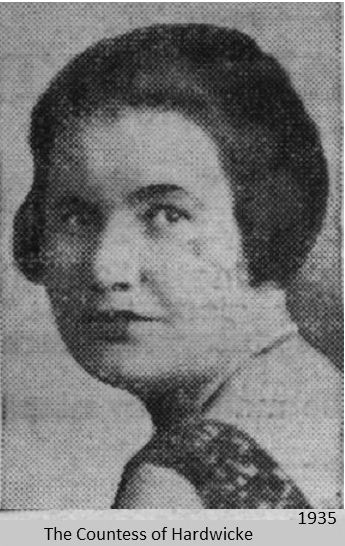
COUNTESS RUNS A BOARDING-HOUSE FOR CATS! FORTY "LODGERS" MEAN A 17-AND-A-HALF-HOUR DAY. Daily Mirror, 2nd September 1935
BOURNEMOUTH, Sunday. To-day I talked with a countess who is earning her living by running a boarding-house for cats at Longham, a village near here. She is the Countess of Hardwicke, who once hated cats, but now is not happy unless she has one or two purring round her. She has no assistant, cheerfully doing all the work herself. For seventeen hours every day she tends her forty charges, many of which are valuable Siamese. Rising at six each morning, she dons overalls and gives the cats a good breakfast, which includes hot milk. Then she cleans out their houses. Each cat has its own little house, its own garden to scratch in and its own tree to climb. Later on the Countess grooms the long-haired boarders and then starts preparing the cats' luncheon of fish or minced meat. When I called at the Countess's flourishing cattery, I found her watching over two sick cats in the little hospital on the premises. Anxious owners had taken them to her, knowing her skill in curing the various diseases that attack cats.
"People ring me up at all hours of the day and night, but I don't mind," she told me. "They often want advice about what to do with a cat which has picked up poison laid down for rats. A man clad only in pyjamas called early one morning and insisted on taking me in a car to see his wife's cat, which had been suddenly taken ill. Sometimes I am called out by the villagers to attend to cows and horses which are queer; I have even been asked to visit sick pigs. But cats are my speciality. I have studied them closely for some years and understand their ailments and their ways.
The Countess has won over 300 prizes and cups at championship cat shows. She started her cattery with a Siamese worth 30s. Now she breeds a great many, and sells about a hundred kittens a year to purchasers from all over the country. A number of distinguished people place their cats under her care, including the wife of a famous artist and a famous author. One of her cats - a " life boarder" - is fifteen years old.
MRS. R. GIBSON
Mrs. R. Gibson, of Annandale, Lenzie, N.B. . .In addition to dogs, Mrs. Gibson is interested in Persian cats, and has a large aviary of canaries, British finches, and other birds. The Gentlewoman, 4th 1918
MISS C. A. D. HAMILTON
Miss C. A. D. Hamilton, of Bannerdown House, Batheaston, Bath [her childhood home was Rozelle, about two miles from Ayr] at one time she bred and exhibited Blue Persians, and was a member of the Cat Club. [As a dog breeder her prefix was Rozelle.] The Gentlewoman, 7th July 1917
MR C. A. HOUSE
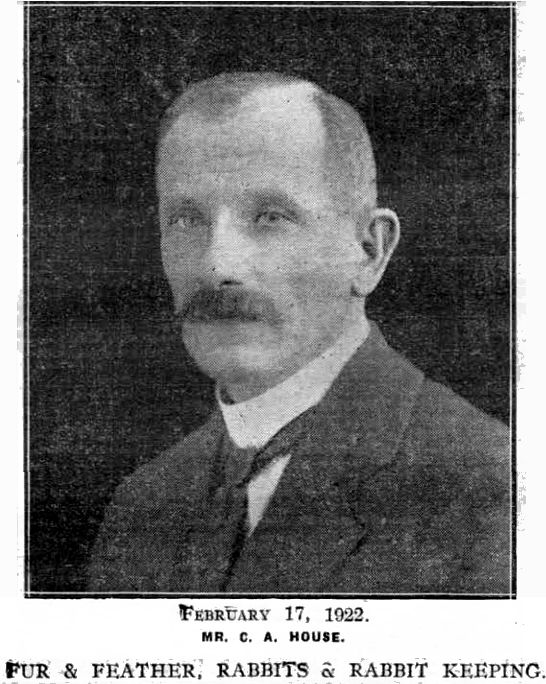
MR. C. A. HOUSE GOES TO AUSTRALIA TO JUDGE. A GREAT HONOUR TO HIM AND TO THE BRITISH FANCY.
Fur and Feather, Rabbits and Rabbit Keeping, February 17, 1922.
As many of our readers already know, Mr. C. A. House has been specially invited by a committee of Australian fanciers to go out to Australia to judge, and on the 18th inst. he leaves London by the Orient liner Osterley, and will arrive at Sydney early in April. This is, indeed, a great honour both to Mr. House and the British Fancy, and as one of that gentleman's oldest fancier friends and fellow-workers, I am very pleased that an old colleague should be so honoured.
Mr. House has been primarily invited to judge the big International Show at Sydney, New South Wales, Australia, to be held in June. The Hon. Dr. Wall, M.L.C., is the president. and Mr. C. W. Bushell, proprietor of The Australasian Pigeon," the secretary of the committee responsible for Mr. House's visit. But this show is only one of a series for which Mr. House's services have been requisitioned. His first engagement as a judge will be at Sydney at the great Easter Show, which will last from April 12th to April 20th. At 16 other important shows, in which every State will participate, will Mr. House officiate as judge. From the time he leaves London till he returns in September he will have travelled over 30,000 miles.
Mr. House will deliver a number of lectures to Australian fanciers, and will not only visit practically every part of Australia, but New Zealand as well, and if he has an opportunity he will also cross to Tasmania, returning across the Pacific and visiting Canada and America. He will get in touch with all the principal fanciers, ascertain their views, investigate their methods, and later give the results in our papers, Fur and Feather and Pigeons and the Short Distance Flyer.
Mr. House s career as a fancier and judge is, of course, well known to practically all our readers, he having been
most prominently before the public in both capacities for over 40 years. He was born on July 13th, 1862. He has successfully bred, exhibited and judged dogs, poultry, pigeons, rabbits, cats and cavies, and he is acquainted with most followers of all these.
He is equally well known as an author of many books on live stock and as a Fancy editor and journalist. In the latter 'eighties he became sub-editor of the old "Fanciers Gazette, under Mr. Edward Brown. In association with Mr. Brown, he also acted as editor of Pet Stock." Since then he has acted as editor of The Fanciers' Gazette, "Fur and Feather, "Poultry and Pigeons, The Homing World," The Bird World." He was the first editor of The Poultry World," and left it - after my serious illness and my then inability to resume active management to take up the position of manager of our concern, The Fanciers Newspaper, etc., Co. - now Watmoughs Limited, of which Mr. House is a director which position he held for eight years, returning in the autumn of 1919 to again take up the editorship of The Poultry World. and to act as chief of the staff of its sister journals, "Cage Birds and "Smallholding and Allotment."
The personal note underlying this reference to the great compliment paid to Mr. House by our Australian friends, and which mainly prompts these lines, is the fad that I have known our friend so long and have had such a close and intimate association with him in so many phases of the Fancy and Fancy journalism. Such being the case, I could not possibly refrain from adding to the send-off to Mr. House of our live-stock contemporaries, and saying a few words of appreciation of my old-time colleague.
My first venture in Fancy newspaper ownership was "Fur and Feather - first called The Rabbit-keeper." This was in 1888. Practically at the very commencement Mr. House joined the staff along with, by the way, another esteemed friend, Mr. T. B. Mason and he has remained on the staff, inside or outside, ever since.
This long and close association probably causes both Mr. House and myself to know more of each other's little faults and weaknesses than most men, and, on the other hand, to better and more fully realise and appreciate, as we do, each other's good properties. It is, at any rate, so with respect to my opinion of Mr. House, and I trust and believe it is the same with that gentleman s regard for myself.
In heartily wishing Mr. House bon voyage, I would add that I think our friend s visit to the Antipodes will do a great deal of good to the Fancy both at home and out there. It can hardly fail to be helpful all round. Mr. House will have much to tell the Antipodenians about the Fancy in this country, and upon his return home he will have a lot to tell us about the position and doings of the Fancy in Australia. Altogether, Mr. House s visit to Australia must bring oversea fanciers and ourselves appreciably closer together, which, obviously, will be beneficial to all concerned. - J. E. Watmough
MR A C JUDE (GENETICIST)
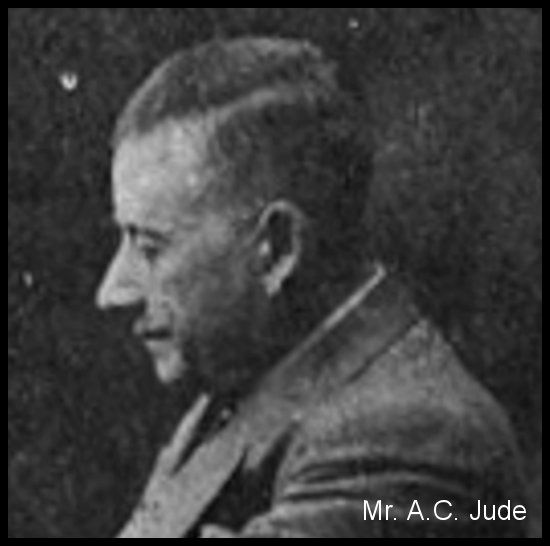
OUR GREAT LOSS. Cats & Kittens, May 1960
Just as this issue was closing for press, I received the shock news that our very good friend and regular contributor, Mr. A. C. Jude, had died following an operation for hernia. The news was all the more tragic because it was thought he had made a good recovery and very soon would be able to return to his home and beloved garden. The complete collapse which occurred on 2nd May was quite unexpected. The death of A. C. Jude is an immeasurable loss to the Fancy and to this Magazine. He filled a unique niche so competently and over the many years of our association I was always acutely aware of his kindliness and willingness to help others with their problems. He had what I can best describe as an almost boyish enthusiasm for his pet subject of genetics and in his gentle way he worked diligently to establish a better world for better animals. I shall always remember A.C, as one who never failed to keep a promise. Maybe he had some presentiment of what lay ahead as although he never complained about any physical trouble and did not mention his visit to hospital, he suggested a short while back that he would like to complete three articles so that I would have something in hand. The first of these appears in this month's issue. I am sure that readers everywhere will wish to join with me in sending sincere condolences to Mrs. Jude and her son John in their bereavement. - Editor.
The following tribute has been received frum Miss Kathleen Yorke, Chairman of the Governing Council of the Cat Fancy:
The passing of Mr. A. C. Jude is a very sorrowful occasion for his family and many friends. So many will always be grateful for the help and kindness he showed to them. For me it was a long friendship and for this I am most grateful. Never once did he fail when I appealed to him for advice on behalf of people all over the cat world. His great knowledge of scientific and genetical subjects he willingly passed on for the inestimable benefit of our Fancy and many are the people who have solved their breeding problems and received encouragement from his writings. Never was any worried enquirer for help left without a full and reasoned reply. I wrote to him some years ago suggesting a series of articles in which he wrote "down" to us instead of "up," as genetics was not always an easy subject for newcomers and novices to grapple with. This he very kindly did and l am sure the series has been of outstanding value all round for the novice as well as the experienced. The knowledge he passed on has educated many and helped substantially to spread the desire for higher standards. Mr. Jude will indeed be greatly missed. - Kathleen Yorke.
MRS. C.L. KENNAWAY
SPETISBURY'S LOSS. DEATH OF MRS. C. L. KENNAWAY (Western Gazette, 26th February 1932)
A Long and Notable Life. Work for Church and Charity. The parishioners of this village and a large circle of friends over a wide area are mourning the passing of Mrs. Edith Letitia Kennaway, wife of the Rev. C. L. Kennaway, of Stephen's Plot, which occurred with suddenness on Friday. Mrs. Kennaway had as usual conducted her Mothers Union meeting in the village, and had walked home with some of the members. Soon after arriving at her home she passed away while seated in her chair. The news was received by the parishioners with the deepest regret, because she was one of the most popular figures in the life of the village.
The deceased lady's life and career was a notable one. Born in 1848, she was married at Sturminster Marshall from her old home at Henbury, and in 1927 she and Mr. Kennaway celebrated their golden wedding. During her long residence in this parish Mrs. Kennaway took an active interest in many of the parochial activities. Amongst her other local associations, she was the leader of the local branch of the Mothers' Union, and the president of the Spetisbury and Charlton Marshall branch of the Women's Institute, an organisation which owes much of its success to her interest and influence. She was also a honorary associate the Girls' Friendly Society, and previously for many years a working associate. In political life occupied the position of chairman of the local branch of the North Dorset Conservative Association. She held a seat on the Committee of the local Nursing Association. An institution that was very near her heart was the Swanage Red Cross Hospital, and she was a tireless worker in its interests. She collected funds for the hospital in many of the surrounding villages and was constantly making arrangements for the children who were wanting admission to this beneficent institution. Mrs. Kennaway also took constant interest in the Village Hall, which building was secured for the use of the parish a few years ago, and had on numerous occasions taken a prominent part in the effots that were made locally to wipe out the debt on the building, now practically accomplished.
Mrs. Kennaway, in common with her husband, was a lover of the sport of foxhunting. She held the distinction of being the oldest original member of the South Dorset Hunt, and first rode with the pack in 1863, in the timne of Mr. C. Radclyffe's mastership. She was still riding with the South Dorset and the Portman packs at the end of last season. A very pleasing incident occurred on the occasion of Mr. and Mrs. Kennaway's golden wedding in 1927. A meet of the South Dorset Hounds was held at Stephen's Plot during that season, and Mr. and Mrs. Kennaway were presented with a beautiful piece of plate, on behalf of the Hunt. Mrs. Kennaway was a successful exhibitor of tortoiseshell cats.
[There was a very long list of people attending the funeral including] Mrs. Campbell Frazer, representing Southern Counties Cat Club.
MR KUHNEL
DON'T DROWN KITTENS! THEY MAY BE WORTH SCORES OF POUNDS. Batley News, 14th June 1907
Interesting Notes on a Profitable Hobby. A Local Fancier Interviewed. When the domestic feline surprises the household by appearing in the family circle tenderly carrying a kitten in her mouth, two things generally happen. First, every likely and unlikely corner of the house is searched to find the remainder of Puss's family, and then a pail of water is obtained in which to consign the little animals to a watery grave. Never do anything of the kind, because even in an ordinary litter there may be a potential champion, who will win honour and glory on the prize bench, and bring its owner a fancy price when sold.
According to Mr. Richard Kuhnel, of Providence Street, Batley, there are thousands of pounds worth of cats drowned every year. And Mr. Kuhnel should know what he is talking about. He has made a study of cats for many years past. As a judge he has been in request at shows all over the country, and his successes as an exhibitor are well known to all cat fanciers. Over 1000 prizes have fallen to him, including the National Cat Club medals, twelve championship medals, 40 cups, silver plates, numerous challenge bowls, and the American Club medal. At present Mr. Kuhnel does not keep a large stud, but while living in Bradford his cattery was like a miniature menagerie. He then had as many as forty cats, thirty of which were champions, and he often won prizes at two or three shows on the same day. The hobby, he says, is a very profitable one. Be has sold prize-winning cats at prices ranging from 40 to 50, and has received over 30 for kittens which had never been shown. Amongst his patrons have been Lord and Lady Alexandra (Balmoral) and Lady Decies (York), names well known in the cat fanciers' world. He was also the originator of the North of England Cat Club, and has filled the office of vice-President and treasurer.
LOCAL FANCIERS. Is the Heavy Woollen district the fancy is fast growing in favour, and there are quite a number who possess animals of first class quality. Amongst these are Mr. J. Redfearn, the well-known rabbit specialist. Mr. Tom Hanley (Batley). Mr. Crawshaw (Heckmondwike), Mr. Rhodes, Miss Ashton, and Miss Burton, and Mr. Wainwright (Ossett).
Our representative gathered from Mr. Kuhnel that one of the fascinations of the fancy was its uncertainty. In the progeny of the most unlikely domestic mouser champions are often found, and from these fanciers have been able to build up a strong stud. He related an instance in which a red tabby kitten was destined to be drowned, but was saved at the solicitation of a fancier, and afterwards won innumerable prizes.
Promoters of cat shows at one time confined their exhibits to fancy animals, such as Persians. It is only within comparatively recent years that the ordinary house cat has come into its own. These are of the shorthaired variety, of which Mr. Kuhnel has made a speciality, and the chief merits about them are markings, shape of head and ears, and length of legs. One advantage which the fancier of cats possess over those who go in for dog breeding is that they have not to pay any license for the animals they keep a very great consideration when the stud is a large one. In order to encourage would-be fanciers, our representative gleaned from Mr. Kuhnel the principal points that are necessary for shorthaired cats.
HOW TO TELL A GOOD CAT. The principal varieties are the silver and red tabbies. Colour is the outstanding point, followed by marking and shape. The prevailing colour about a silver should be that of a new shining, with black markings round the body and three black streaks from the back of the neck to the end of the tail. The head must be broad and chubby, and the ears small and well separated, a cat with ears too near its eyes being "no class." The tail should be nicely ringed, but with not more than four rings, and the animal must stand on short legs and small feet. The markings on a good red tabby are exactly similar to those on a silver. In red tabbies nut brown or deep orange eyes are an essential, and silvers should possess either green or amber optics, the former being preferred. Another favourite English cat is the pure white. These must possess China blue eyes, otherwise they are valueless. When first introduced to the Show bench yellow eyes predominated in this breed, and there were some with odd eyes, but at the present time a pair of perfect blue eyes are a sina qua non.
One of the most difficult animals to breed in the whole feline world is a perfect tortoiseshell; in fact, Mr. Kuhnel says that a perfect specimen has not yet been produced, the best being one owned by Mr. J. Rhodes, of Ossett, which fails in the eyes. The perfect tortoiseshell should have patches of red, black, and amber equally distributed all over its body, tail, and legs, and the eyes should be orange colour. Another peculiarity about the tortoiseshell is that very rarely is an animal of the male persuasion to be found in the breed. The only one at present known on the Show bench was bred by a Darlington man, and is now owned by Lady Alexandra. This animal is far from being a perfect specimen, but being by itself is able to carry off the Crystal Palace prize of 5 given every year for the best tortoiseshell "Tom." Tortoiseshells are generally bred from a cross between a black English cat and a red tabby, although cases have been known in which cats of another colour have bred them. The tortoiseshell, in fact, must be regarded as somewhat of a freak in the cat fancy.
A new short-haired variety which is rapidly coming to the front is the Abyssinian bunny cat. These are of a brown colour, but the chief point about them is the "ticking." They are most peculiar looking animals, but are gaining in favour day by day. Yet another variety is the Siamese, which is exactly like a pug dog in markings, the body being fawn, with black muzzles, while some have fawn bodies with blue or chocolate muzzles. The eyes of the Siamese, like the English white, must be a China blue.
A favourite with cat fanciers is the tortoiseshell and white, a variety quite distinct from the ordinary tortoiseshell. These are red, black and white in patches, the more patches there are the better the quality of the cat. One with patches equally distributed on the back is, said Mr. Kuhnel, worth from 20 to 30. An orange eye is another point in favour of this breed. Mr. Tom Hanley possesses one with which he secured a first and special and second at the Batley Show. Mr. Hanley is also the possessor of "Coronation King, a red tabby bred by Mr Kuhnel. and which is regarded as one of the best of its breed. The Blue Russian, though regarded as a short-haired cat, is rather more wooly than the other varieties. They are slaty blue in colour, and should have short stumpy bodies, massive heads and bones, and orange eyes.
FEEDING AND KEEPING. So much for the different varieties. Now for a word or two about the feeding and keeping of show cats. They should, says Mr Kuhnel, be penned like rabbits, but given a little more room. The show cat is the aristocrat of the feline world, and must not be allowed to rom about at will, and stay out late at nights like the common or garden tabby. A cat should be places in a pen about a yard and a half in length, and about three quarters of a yard broad. By placing in the pen an earth box and teaching the animal cleanly habits, disagreeable smells are avoided.
With regard to the feeding of cats, Mr Kuhnel deprecates pampering or over-feeding. Cats, he says, thrive best on a diet of fish heads and boiled rice. The latter should be boiled to a jelly, and then allowed to cool, when it can be given with fish heads, which must also be boiled. Cats do not require much milk, a supply of clean water being preferable for drinking.
With the above hints before them, lovers of cats should be able to improve their knowledge of the show points of their favourites.
MISS LEA
MISS H.M. LEA. Sydenham, Forest Hill & Penge Gazette, 19th October 1934
We regret to learn of the death of Miss Henrietta Maria Lea. who resided at 1, The Firs, Westwood-road, Sydenham, and who passed away on Friday. Her death will be keenly regretted by lovers of animals, in which she took great interest. She was a well-known judge at cat shows. The funeral, which was entrusted to Messrs. Walter Cobb, Kirkdale, took place on Tuesday, when the remains were cremated at the West Norwood Crematorium. The Vicar of St. Bartholomew's (Rev. L. P. Smith) officiated at the religious service, which was attended by a number of friends. Numerous beautiful floral tributes were received.
MISS LIVINGSTONE
MISS LIVINGSTONE'S CATS - The Ladies Field, February 15, 1908, by Dick Whittington
MISS LIVINGSTONE of Glencairn, Lanark; is well-known as a most successful exhibitor of neuter cats. She has in all ten cats, six of which, a long-haired white, a short-haired white, an orange, a cream, a chinchilla, two Siamese and a white Manx, are neuters. There are but two female cats, Dolly, a large blue daughter of Mark Antony, and Phyllis, a pretty orange-eyed white. Both these were bought from Mrs. Longwill about six years ago, but Miss Livingstone does not go in for breeding, as she does not care to part with her pets. The two Siamese are Eoin and Togo of Drayton, and are from the Royal Siam and King Kesho strain. Togo is perhaps the better marked cat, but he has a badly kinked tail, while Eoin s tail is straight. These cats have won a number of firsts, specials and medals, but Miss Livingstone does not intend to risk them at any more shows.
Sam was once a beautiful blue-eyed white, but many thrilling adventures and misfortunes have rubbed the polish off a little. Once, when on a visit, he disappeared from Sunday until Friday night, when he was discovered by the organist concealed in the organ in church. On another occasion he tried conclusions with an express train and lost half his tail, one eye and all but one of his teeth. Since then a gathering in his ear has caused it to shrivel up; so, though strong and well, he presents a somewhat battered appearance. Monxie is an imported white Manx, winner of four firsts, two seconds, two medals, some specials and the S.H.C.S. cup for best neuter at Edinburgh, though he has only been to five shows. He could not be exhibited last year, as he was then recovering from an attack of inflammation of the lungs. Glencairn Chrystal II, is a lovely long-haired blue-eyed white. He is by Ch. Lord Abercorn ex a daughter of Ch. White Friar. Glencairn Frederick is a fine orange, very sound in colour, and winner of many firsts and specials. Alphonso, his brother, a pale cream, has not yet been shown. Muffy, the chinchilla, is also a winner, but rats and mice are his speciality.
Miss Livingstone s cats and dogs are, as may be seen, great friends. The cats have a very varied diet, which includes raw and cooked meat, fish, milk, porridge, arrowroot, vegetables, etc. The cats all sleep indoors, and have as much liberty as possible during the day. They have little outdoor houses and runs, but these are never used during bad weather. Miss Livingstone believes in washing her cats; she also cleans them with hot bran or with fuller s-earth.
MR. T.B. MASON (SHOW JUDGE)
[T.B. MASON] Bradford Weekly Telegraph, 24th January 1903
A contemporary [journal] devoted to cats - a fancy so popular in fashionable society - has something very complimentary to say about Mr. T. B. Mason, of Idle, the well-known judge, of the smaller species of live-stock. The journal says: "It is curious and interesting to note the great popularity of Mr. T. B. Mason as an all-round judge of cats. He seems to have slipped into the shoes of poor Welburn, and now no big cat show is complete without him. All the specialist societies gladly support him, and, as is well-known, specialist societies are hard to please. Mr. Mason has a thoroughly sound knowledge of cats, he keeps cool, and goes on his way caring for nobody; he does not show annoyance, and is always ready to discuss an award in an amiable spirit; the result is that I have yet to meet an exhibitor who will not show under him."
[T B MASON] Shipley Times and Express, 10th July 1908
Mr. T. B. Mason, of Idle, the well-known pet livestock judge, has been invited by the committee of the Atlantic Cat Club to officiate as one of the judges at the great show to be held in the Madison Square Gardens, New York, on December30th and 31st, and January 1st, 1909. Owing to previous engagements, Mr. Mason has had to decline the invitation. But I understand that he is contemplating taking a trip to Canada and the United States a little later and will arrange to visit some the big shows during his stay. Evidently the Yankees think something of the Idle cat judge, who, wherever goes, lets the people know that he is proud of being Yorkshireman.
MARRIAGE OF MR. T. B. MASON. (Shipley Times and Express, 6th August 1909)
The marriage took place yesterday (Thursday) at Croydon of Mr. T. B. Mason, Idle, and Miss Kate Sangster [a noted breeder of cats]. Southampton, hon. secretary of the Southern Counties Cat Club. In order to mark the occasion of the marriage the staff and employees of the Fanciers Newspaper and General Printing and Publishing Co . Idle, with which Mr. Mason has been concerned for over twenty years, have presented him with a handsome smoker s cabinet. Mr. and Mrs. Mason are to reside at Lincoln House, 12b. Benshaw Manor Road, Thornton Heath.
DEATH OF MR. T. B. MASON Shipley Times and Express, 14th December 1923
One of the best known judges of rabbits, cavies and cats in the country, Mr. Tom B. Mason, died Southport on Thursday of last week. Mr. Mason, who was a native of Idle, had grown up in the fancy, and was known as a most competent judge in practically every city and town in the kingdom. Had he so desired, he could have allowed his activities to cover a wider zone, for he was several times invited to visit America during the Belgian hare boom in that country. Mr. Mason never accepted these invitations, but became a great authority on these animals and was frequently called-in by ladies who indulged in the craze at that time, and who sought advice from the best possible sources. The interment took place at Idle on Tuesday afternoon, following a service at Idle Upper Chapel, conducted by the Rev. F. C. Vaughan Bishop. Mr. Mason had been connected with the firm of Fur and Feather, and employers from the machine-room department of Watmough s, Ltd., acted as bearers. Mr. John Garnett represented the firm of Watmough s, Ltd., Mr. E. Grey the printing department, Mr. Allan Watson Fur and Feather." The Airedale Agricultural show was represented by Messrs. B. Battle (secretary), . . . [there was no mention of a widow.]
MRS. M. VLASTO
Mrs. M. Vlasto [. . .] Previously she bred cats, specializing in brown tabby, and long-hairs, but though very successful in showing was discouraged by the extreme difficulty in rearing kittens. The experience gained, however, has stood her in good stead with Pekingese. The Gentlewoman, 12th December 1925
MR F.W. WESTERN
SEVERE LOSS TO THE COUNTY. DEATH IN NURSING HOME OF MR. F. W. WESTERN, SECRETARY OF SANDY SHOW Bedfordshire Times and Independent, 8th December 1939
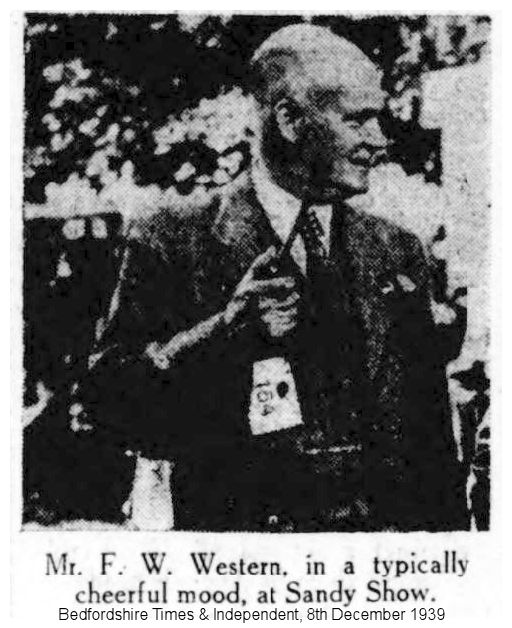 A keen sense of regret was experienced in East Bedfordshire, indeed throughout the County, on Tuesday morning when it was learned that the death had occurred the previous evening of Mr. Frederick William Western, JP, of Holme Grove, Biggleswade. He was sixty-four. He was taken ill early in October, having to be driven home from his market. On 11th November he was admitted to a Bedford nursing home where he was given every care and attention by the staff - but in vain. He underwent an operation on 18th November.
A keen sense of regret was experienced in East Bedfordshire, indeed throughout the County, on Tuesday morning when it was learned that the death had occurred the previous evening of Mr. Frederick William Western, JP, of Holme Grove, Biggleswade. He was sixty-four. He was taken ill early in October, having to be driven home from his market. On 11th November he was admitted to a Bedford nursing home where he was given every care and attention by the staff - but in vain. He underwent an operation on 18th November.
Born in Torquay, Mr. Western came at the age of seven with his parents, the late Mr. and Mrs. William Western, to live at Sandy, where Mr. Western, senior, established the tailoring and outfitting business now under the proprietorship of Mr. F. W. Western's brother, Mr. George Western. He leaves a widow and one daughter, Mrs. C. R. Westlake. of Finchley. There are two grandchildren.
Multifarious Interests. Few men in Bedfordshire could have been more intimately connected with the public life than Mr. Western. His interests were legion. But that which must have been most close to his heart, for which he would undoubtedly rather be remembered that anything else, and in connexion with which his name was a household word, was the Sandy Horticultural Society. For years he had been the mainspring in the complicated machinery which year after year raised the Society s annual show from local to County and then to national fame. His calm confidence in this organization was a byword, and even this year, although on the brink of what he must have known would be a serious illness, that organization did not suffer. With the imminent threat of war hanging over the arrangements he calmly went ahead, rallying one or tow of his more pessimistic followers, and despite every handicap rescued the Society from a loss which, had the show been cancelled, would have swallowed up all the reserves.
His connexion with the show, in an official capacity, began in 1898, when he was appointed livestock clerk. In 1902 he became livestock secretary and in 1913 general secretary. This position he has held ever since, except of course, for the inevitable break during the last war.
Biggleswade Auctioneer. In his business Mr. Western was principal of the firms of F. W. Western and Co. and Maddison and Western, both of which he established in 1897, the latter firm running the weekly cattle market at Biggleswade. The firms were joined by Mr. Brian S. Porter in 1936 as partner. In his capacity as auctioneer he was a Fellow of the Auctioneers Institute and had recently been appointed District Chairman of Auctioneers under the Food Control Scheme. Even here his auctioneering abilities did not end. for he was honorary auctioneer to Crufts Show. Mr. Western was reputed to be one of the best judges of cats in Europe and last year he was secretary of the Southern Counties Cat Show. He judged at many livestock shows of all kinds all over this country and on the Continent Several years ago he was a prominent cat fancier himself.
All his life Mr. Western was a Methodist, and here again the ramifications of his work were amazing. He had been a local preacher since 1902 and was a fluent and forceful speaker. He was secretary of the Biggleswade Methodist Circuit Quarterly meetings, and joint secretary of the Foreign Missions branch of the Circuit. He was treasurer of the Beeston Methodist Church Trust and always had a warm spot in his heart for this little church. He was a Circuit representative on the North London District Methodist Synod.
Local Government Activities. For years he was a member of the bench of magistrates, of which at one time he was vice-chairman. For election after election he was re-appointed a member of the Biggleswade Urban Council. He first became member in April 1925 and remained so until he died. In the year 1927-1928 he was elected chairman. His extraordinary mastery of figures led to his appointment as chairman of the Finance Committee and his summing up of the financial situation at the end of each of his nine years of office earned him the title of The Chancellor of the Exchequer . He was succeeded in this position eighteen months ago by Mr. H. Phillips. For a time also he was chairman of the Highways Committee. Local government also claimed him among the ranks of its officials. On 26th November 1896 he was appointed Clerk to the old Sandy Parish Council and Assistant Overseer at Sandy. When the town gained urban status on 1st April 1927 he continued in his capacity as Clerk, in which position his judgment was trusted implicitly by the members whenever they needed advice. He was also Clerk to the Northill, Tempsford. and Blunham Parish Councils. He was secretary of the Sandy Town Hall Company.
In politics he had always embraced the Liberal traditions, although he had not been so intimately connected with this phase of his activities as in other directions, mainly because of his business. He was a vice-president of the Sandy Liberal Club and of the Biggleswade Liberal Club. Freemasonry had claimed his interests for about twenty years, and he was a Past Master of the St. Andrew's Lodge at Biggleswade. In addition, he was Past-Grand Deacon of the Provincial Lodge, and member of the Ampthill Royal Arch Chapter.
Sport. Last but by no means least was his interest in sport. Probably the sport he loved most, at least in later years, was bowls. He was a playing member of the Sandy and Biggleswade Conservative Bowls Clubs and became almost as well known on the Clacton bowls greens, where he competed year after year, as on those of his home district. Years ago, he played cricket for the now non-existent Sandy club. Football also numbered him among the ranks of its devotees. He was president of the Biggleswade and District Football Club and of the North Bedfordshire Charity Football Cup competition. In their more palmy days he would nearly always be found on the grandstand at the Waders matches. He was president of the Biggleswade Billiards League.
The Funeral. The funeral has been arranged to take place to-day (Friday). A service at Trinity Methodist Church, Biggleswade, conducted by the Superintendent Minister (the Rev. Ernest Nicholas) at 2 p.m.. will precede the interment at Sandy Cemetery at 2.45 p.m.
Court Tribute. Before the business at the Biggleswade Sessions Wednesday, the Chairman (Mr. F. W. Braybrooks) said that since they had last met a fellow-magistrate had been taken from them. He had been a magistrate for twenty-one years and for a number of years he had been vice chairman of the Bench. They remembered him from those early days when Mr. Alfred Inskip was chairman; how eager, capable, gifted, and willing he was to pull his weight in every good cause. They greatly regretted his loss. Mr P. R. Chaundler, on behalf of the solicitors practising at the Court, and Superintendent C. Leist associated themselves with the Chairman s remarks.
An Appreciation. Mr. W. H. McKelvey (chairman of the Sandy Show Committee) writes: "Frederick William Western attended every Sandy Show from 1898 to 1939 and was known and respected throughout the British Isles. He first became prominent as an exhibitor of cats (which were shown in the name of his wife). Later he became a judge and after the death of Mr. T. B. Mason was considered the finest judge cat in England, perhaps in the world. Practically every cat show in England had him as judge at some time or other, and he also judged on the Continent. He was particularly interested in tortoiseshells and whites, and many local people have been surprised and delighted to receive an offer of a pound from Mr. Western for a cat thought to be fit only for catching mice. Later this same cat would be groomed to stardom and would astound some judge. He progressed from cats to dogs and took up the breeding, exhibiting, and judging of collies. His collie. Charles Rosdew will be remembered by the older collie exhibitors as an outstanding specimen of what a good collie should be. Immediately after the war, when rabbits became fashionable in the show world, he became interested in silver-grey rabbits, and here again his enthusiasm for anything to which he put his hand enabled him become the foremost breeder and exhibitor and judge of this variety. In later years he gave up exhibiting and confined himself to judging, and in this sphere his services were in such demand that he was not able to accept all the appointments offered him.
Freddy Western and Sandy Show are synonymous terms. No one spoke of the one without mentioning the other. His knowledge of organization and detail was unrivalled and the Society cannot hope to adequately to fill his place. He knew all the leading exhibitors personally, and on the day of the show was their guide, philosopher, and friend. His good humour and 'hail-fellow-well-met' attitude on show day when he was burdened with a thousand details and difficulties were something to marvel at. He was never too busy to smooth away any troubles and set the perplexed exhibitor s mind at rest. He worked with complete harmony with his show committee and often managed to get his own way without them knowing it. The work tor Sandy Show will go on, as he would have wished. We know that the thousands of well-wishers of this old-established Society will look forward to the days of peace and a return of Sandy Show on the last Thursday in August. Freddy will not be there but his spirit will.
MR CYRIL YEATES
A biography appeared in "Cat Gossip," 7th December, 1927, with the note "The biographical notes and portraits are taken from our late contemporary, 'Animals.' "
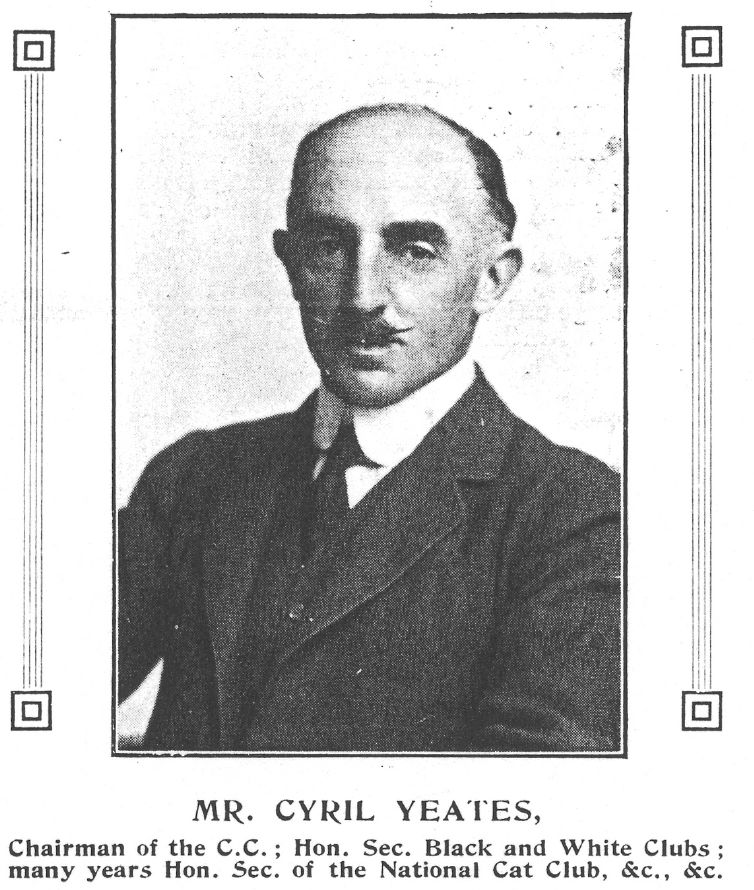
Mr. Cyril Yeates, Hon. Sec. National Cat Club. A native of Kendal, Westmoreland. Educated at Haleybury and the R.M.C., Sandhurst. Has only shown one cat, but as it was through this cat s mother he met Mrs. Ycates, firmly believes black cats are lucky! First took interest in Cat Shows in 1906. Became Hon. Sec. of the Black and White Club 1921. Hon. Sec. N.C.C. in 1923. Ran Kensington Show with Miss Frances Simpson in 1922; Show Manager S.C.C.C., 1925; and ran 1923-7 Palace Shows. Has been on G.C. since 1921. Favoourite cats, tortie-and-white and Dutch-marked L.H., silver tabby S.H. Compiler of the Supplement to Vols. I. and II. of the G.C. Stud Book. A member of the Dumb Friends' League for 26 years. Favourite hobbies - Yachting, horse-racing, and the theatre.
